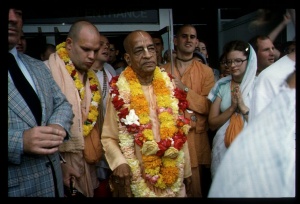CC Madhya 2.35 (1975): Difference between revisions
(Vanibot #0027: CCMirror - Mirror CC's 1996 edition to form a basis for 1975) |
(Vanibot #0020: VersionCompareLinker - added a link to the Version Compare feature) |
||
| Line 2: | Line 2: | ||
<div style="float:left">'''[[Sri Caitanya-caritamrta (1975)|Śrī Caitanya-caritāmṛta (1975)]] - [[CC Madhya (1975)|Madhya-līlā]] - [[CC Madhya 2 (1975)|Chapter 2: The Ecstatic Manifestations of Lord Śrī Caitanya Mahāprabhu]]'''</div> | <div style="float:left">'''[[Sri Caitanya-caritamrta (1975)|Śrī Caitanya-caritāmṛta (1975)]] - [[CC Madhya (1975)|Madhya-līlā]] - [[CC Madhya 2 (1975)|Chapter 2: The Ecstatic Manifestations of Lord Śrī Caitanya Mahāprabhu]]'''</div> | ||
<div style="float:right">[[File:Go-previous.png|link=CC Madhya 2.34 (1975)|Madhya-līlā 2.34]] '''[[CC Madhya 2.34 (1975)|Madhya-līlā 2.34]] - [[CC Madhya 2.36 (1975)|Madhya-līlā 2.36]]''' [[File:Go-next.png|link=CC Madhya 2.36 (1975)|Madhya-līlā 2.36]]</div> | <div style="float:right">[[File:Go-previous.png|link=CC Madhya 2.34 (1975)|Madhya-līlā 2.34]] '''[[CC Madhya 2.34 (1975)|Madhya-līlā 2.34]] - [[CC Madhya 2.36 (1975)|Madhya-līlā 2.36]]''' [[File:Go-next.png|link=CC Madhya 2.36 (1975)|Madhya-līlā 2.36]]</div> | ||
{{CompareVersions|CC|Madhya 2.35|CC 1975|CC 1996}} | |||
{{RandomImage}} | {{RandomImage}} | ||
==== TEXT 35 ==== | ==== TEXT 35 ==== | ||
<div class="verse"> | <div class="verse"> | ||
: | :kari' eta vilapana, prabhu śacī-nandana, | ||
:ughāḍiyā hṛdayera śoka | :ughāḍiyā hṛdayera śoka | ||
:dainya-nirveda-viṣāde, | :dainya-nirveda-viṣāde, hṛdayera avasāde, | ||
:punarapi paḍe eka śloka | :punarapi paḍe eka śloka | ||
</div> | </div> | ||
| Line 20: | Line 19: | ||
<div class="synonyms"> | <div class="synonyms"> | ||
kari'-doing; eta—such; vilapana—lamenting; prabhu—the Lord; śacī-nandana—the son of mother Śacī; ughāḍiyā—opening; hṛdayera—of the heart; śoka—the lamentation; dainya—humility; nirveda—disappointment; viṣāde—in moroseness; hṛdayera—of the heart; avasāde—in despondency; punarapi—again and again; paḍe—recites; eka—one; śloka—verse. | |||
</div> | </div> | ||
| Line 34: | Line 33: | ||
<div class="purport"> | <div class="purport"> | ||
In the Bhakti-rasāmṛta-sindhu, the word dainya (humility) is explained as follows: | In the Bhakti-rasāmṛta-sindhu, the word dainya (humility) is explained as follows: "When unhappiness, fearfulness and the sense of having offended combine, one feels condemned. This sense of condemnation is described as dīnatā, humility. When one is subjected to such humility, he feels physically inactive, he apologizes, and his consciousness is disturbed. His mind is also restless, and many other symptoms are visible."1. | ||
Can you look this quote up and see if it ends where we indicate? | |||
(1) The word nirveda is also explained in the Bhakti-rasāmṛta-sindhu: "One may feel unhappiness and separation, as well as jealousy and lamentation, due to not discharging one's duties. The despondency that results is called nirveda. When one is captured by this despondency, thoughts, tears, loss of bodily luster, humility and heavy breathing result." Viṣāda is also explained in the Bhakti-rasāmṛta-sindhu: "When one fails to achieve his desired goal of life and repents for all his offenses, there is a state of regret called viṣāda." The symptoms of avasāda are also explained: "One hankers to revive his original condition and inquires how to do so. There are also deep thought, heavy breathing, crying and lamentation, as well as a changing of the bodily color and drying up of the tongue." | |||
In the Bhakti-rasāmṛta-sindhu thirty-three such destructive symptoms are mentioned. They are expressed in words, in the eyebrows and in the eyes. These symptoms are called vyabhicārī bhāva, destructive ecstasy. If they continue, they are sometimes called sañcārī, or continued ecstasy. | In the Bhakti-rasāmṛta-sindhu thirty-three such destructive symptoms are mentioned. They are expressed in words, in the eyebrows and in the eyes. These symptoms are called vyabhicārī bhāva, destructive ecstasy. If they continue, they are sometimes called sañcārī, or continued ecstasy. | ||
</div> | </div> | ||
Latest revision as of 12:24, 27 January 2020

A.C. Bhaktivedanta Swami Prabhupada
TEXT 35
- kari' eta vilapana, prabhu śacī-nandana,
- ughāḍiyā hṛdayera śoka
- dainya-nirveda-viṣāde, hṛdayera avasāde,
- punarapi paḍe eka śloka
SYNONYMS
kari'-doing; eta—such; vilapana—lamenting; prabhu—the Lord; śacī-nandana—the son of mother Śacī; ughāḍiyā—opening; hṛdayera—of the heart; śoka—the lamentation; dainya—humility; nirveda—disappointment; viṣāde—in moroseness; hṛdayera—of the heart; avasāde—in despondency; punarapi—again and again; paḍe—recites; eka—one; śloka—verse.
TRANSLATION
Lamenting in this way, Śrī Caitanya Mahāprabhu opened the doors of grief within His heart. Morose, humble and disappointed, He recited a verse again and again with a despondent heart.
PURPORT
In the Bhakti-rasāmṛta-sindhu, the word dainya (humility) is explained as follows: "When unhappiness, fearfulness and the sense of having offended combine, one feels condemned. This sense of condemnation is described as dīnatā, humility. When one is subjected to such humility, he feels physically inactive, he apologizes, and his consciousness is disturbed. His mind is also restless, and many other symptoms are visible."1.
Can you look this quote up and see if it ends where we indicate?
(1) The word nirveda is also explained in the Bhakti-rasāmṛta-sindhu: "One may feel unhappiness and separation, as well as jealousy and lamentation, due to not discharging one's duties. The despondency that results is called nirveda. When one is captured by this despondency, thoughts, tears, loss of bodily luster, humility and heavy breathing result." Viṣāda is also explained in the Bhakti-rasāmṛta-sindhu: "When one fails to achieve his desired goal of life and repents for all his offenses, there is a state of regret called viṣāda." The symptoms of avasāda are also explained: "One hankers to revive his original condition and inquires how to do so. There are also deep thought, heavy breathing, crying and lamentation, as well as a changing of the bodily color and drying up of the tongue."
In the Bhakti-rasāmṛta-sindhu thirty-three such destructive symptoms are mentioned. They are expressed in words, in the eyebrows and in the eyes. These symptoms are called vyabhicārī bhāva, destructive ecstasy. If they continue, they are sometimes called sañcārī, or continued ecstasy.